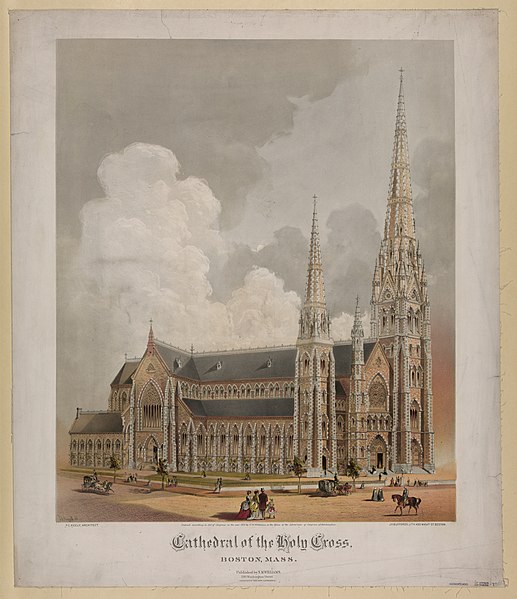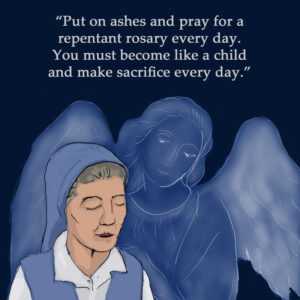Father Higgins: The Charlestown Convent Burning
In last my last article, I made reference to the burning of the Ursuline Convent School in Charlestown, Massachusetts, by an anti-Catholic mob on August 11th, 1834, one the worst acts of anti-Catholic violence in our nation’s history. Since the history of this event is little-known I would like to recount it here in more detail.
A beautiful convent school run by the Ursuline Sisters was erected on a hill in Charlestown, Massachusetts in the late 1820s (presently, this spot is now within the boundaries of the city of Somerville). The Bishop of Boston Benedict Fenwick, who was only the second bishop of this young diocese, was a Jesuit priest who had been the president of Georgetown College. He and the Mother Superior of the Ursulines Madame St. George saw this convent school as a way to make the Catholic Church more respectable in the Puritans’ own city of Boston.
Mount Benedict would not be a school for poor Irish girls—but an elegant academy that would attract the daughters of Boston’s and other cities’ elite. It would be a high-priced school that would use Protestant money to help build the Roman Catholic mission in the area. The refined Ursulines would improve the image of the Church Fenwick was anxious to mainstream, and the girls graduating from Mount Benedict would influence their husbands and sons to look benevolently on a growing Catholic presence.
Both Bishop Fenwick and Madame St. George badly underestimated the depth of anti-Catholic feeling in Boston. They did indeed attract a wealthy clientèle to the school from socially prominent Unitarians, but the sight of rich men’s daughters patronizing a Papist nunnery had the unintended effect of fomenting social class resentments on top of the anti-Catholic religious bigotry, especially among the Protestant migrant workers in the Charlestown brickyards.
The immediate cause of the mob attack on the Ursuline convent was the wild rumor that a “Mysterious Lady” had escaped from the convent and had been dragged back there as a prisoner. The kernel of truth was that one of the Ursulines did suffer a mental breakdown and had fled to a neighbor’s house. After a few days she recovered and went back to the convent.
When a delegation of Charlestown Selectman came to investigate, they were allowed to meet with the Sister-escapee and to search the convent. It was too late, however, to stop the mob-action which the brickmakers were organizing for the night of August 11th, 1834.
The mob came in the middle of the night. Madame St. George faced them down from a second-story window, which only provoked the invaders even more. As the ring-leader later recounted of the Mother Superior: “She was the sauciest woman I ever heard talk!”
The attackers broke down the heavy wooden door and streamed into the convent. The Mother Superior had the Sisters quickly gather the girls from their dormitory and hide with them in their garden. Two of the Ursulines went to their oratory and carried away the heavy tabernacle with the Blessed Sacrament. They hid it in a large rosebush in the garden.
Once they had breached the entrance the rioters carried out a wanton destruction of the convent, hurling expensive furniture out the windows and smashing the musical instruments which were the property of the students, several pianos and harps. When they found the mausoleum where several Sisters had been buried they opened the coffins and desecrated the corpses. Also discovered was the mahogany tabernacle “hidden in an especially beautiful rosebush, covered with voluptuous red blooms of an overpowering fragrance.” After prying it open one of the rioters yelled mockingly “Now I have God’s body in my pocket!” as he stuffed some of the Hosts into his shirt pocket. Meanwhile,z all of the buildings of the convent were set on fire and they burned until the fires burned themselves out. In the midst of the mayhem the Sisters and their student charges managed to escape through the back of the gardens and sought safety with neighbors.
Although the convent had been utterly destroyed the beautiful terraced garden which the nuns had cultivated remained. The next night, however, many of the rioters returned with the object of destroying this garden.
They pulled the vines laden with ripening grapes from trellises. They swung axes at apple and pear trees heavy-hung with fruit. They trampled neat green rows of lettuce and broccoli, and hurled tomatoes and bean plants skyward. Finally, they trampled the rose bushes, even as the thorns tore at their clothes and skin.
Mount Benedict was left a ruined, desolate hill, a haunted place which would remain in that condition for another fifty years.
The reaction among the people of Boston was mixed. One sector of the population was horrified, especially as it was an act of violence carried out by a mob of men against a house of defenseless women and girls. But for another sector of the population it was seen as a good start. There was a great deal of popular support for the rioters and their direct action in driving out the Papists.
The people of Charlestown closed ranks against the attempts of the authorities to investigate the mob-attack on the convent. As one handwritten placard posted on the Charlestown Bridge warned:
All persons giving information in any shape, or testifying in court against any one concerned in the late affair at Charlestown, may expect assassination, according to the oath which bound the party to each other.
With great difficulty, several of the more notorious culprits were eventually charged and put on trial, but the trial became bogged down in the peculiarities of Catholicism rather than what had been done by a vigilante mob against a convent. It was as if their violence were somehow justified as an expression of the collective righteous rage of a true Christian people against the tolerance of idolaters (viz., Roman Catholics) in their midst.
When the ring-leader and the first to be tried, a man named John R. Buzzell, was acquitted the courtroom erupted in hooting and applause from the spectators. He was welcomed back to Charlestown like a conquering hero, with cheering throngs in the streets. All but one of the defendants was ever found guilty in either civil or criminal court. The one guilty verdict was against a teen-age boy who, showing-off, had set himself up as an auctioneer while the mob was throwing Bishop Fenwick’s books into the fire. He was sentenced to life imprisonment. Popular feeling quite rightly was indignant, as the boy was obviously being used as the scapegoat for the whole mess. Both Bishop Fenwick and the Mother Superior petitioned for his released. The Governor of Massachusetts did pardon him after a few months.
There was never any redress or accountability to the Ursulines or the Catholic Church of Boston for the destruction of the Charlestown convent.
On June 9th, 1835, when the last of the convent rioters was acquitted, Bishop Fenwick wrote in his diary:
Great rejoicing in Charlestown among the blackguards on Saturday in consequence of their acquittal—fifty guns were fired on the occasion! Thus iniquity has prevailed at last!
Instead the Charlestown Convent Burning ushered in a “new normal” for Catholics in Boston and in the United States in general. After the fire the Ursulines attempted to re-establish their academy in Roxbury, but they were threatened with further violence from Protestant vigilantes.
On the Sunday after Epiphany, January 11th, 1835, when he went to celebrate Mass for the Ursulines, Bishop Fenwick learned that:
During the whole of the preceding night bands of ruffians in sleighs were passing, repassing and stopping in front of the house where the Ursulines were now lodged, using the most profane language and singing aloud; down with the Convent! and the most lascivious and indecent songs to the great annoyance of the poor religious. This practice…has been in place for the last week. The poor Nuns are disconsolate—not having enjoyed any rest the preceding night. None of them are ready for confession or communion this morning from the state of confusion into which they are thrown in consequence of these proceedings.
Fire and Roses: The Burning of the Charlestown Convent, 1834, by Nancy Lusignan Schultz, the Free Press, 2000
Later that year Bishop Fenwick had the Ursulines sent to Quebec.
One year after the burning of the Ursuline Convent of Mount Benedict, at the end of August, 1835, a terrible fire broke out in Charlestown and destroyed much of the city. It seemed to have the character of a divine chastisement, as Bishop Fenwick confided to his journal:
It would seem almost a visitation of God for the horrid outrage committed by the inhabitants of this Town upon the Ursuline Convent on the 11th of last August. It is reported in the Papers that even some lives are lost.
Bishop Fenwick invited the remnant of the Ursuline Community to return from Quebec and try to re-establish their school, which they did in August, 1838, four years after the Convent Burning. The whole project failed miserably. Many parents feared to send their daughters after what had taken place. Moreover there was internal dissension within the Sisters’ Community. The Ursulines relinquished the Mount Benedict property to the Bishop of Boston in return for the payment of their debts.
On August 11th, 1846, twelve years to the day of the Charlestown Convent Burning, Bishop Fenwick died. He was sixty-four years of age. He was buried on the campus of the College of the Holy Cross, in Worcester, Massachusetts, which he had founded in 1843.
For fifty years after its destruction, Mount Benedict remained a haunted ruin. One commentator, in 1870, wrote:
“The Convent walls, blackened by the conflagration, are still standing, and the once beautiful grounds are wild and desolate.”
And another, in 1874:
“When we last visited the spot the scene was one of utter loneliness. Year by year the walls have been crumbling away, until the elements are fast completing what the fire spared.
At last, in the 1870s the property was sold by the Archdiocese of Boston for landfill and housing. The proceeds, however, were used to help pay for the construction of Boston’s new Cathedral of the Holy Cross which stands in the South End of Boston today. Some bricks from the Convent ruins were re-purposed to form the arch in the entranceway to the new Cathedral.
The house in Roxbury, Brinley Place, which the Ursuline Sisters had rented for their school in the months immediately following the Burning, until Bishop Fenwick had them recalled to Quebec for their safety also had a “rest-of-the-story” in Boston Catholic life. In 1869 the property was purchased by the Redemptorist Fathers and in 1876 they laid a cornerstone for a new church. That church we know well today as the “Mission Church”, Our Lady of Perpetual Help.
Father Jeremiah Higgins is pastor of Mary Immaculate of Lourdes in Newton, MA, a two-form parish of the Archdiocese of Boston




